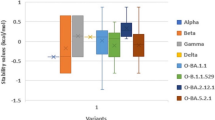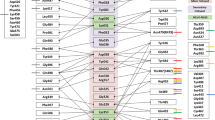Abstract
We constructed a quantum model of the receptor-binding domain (RBD) of the wild-type SARS CoV-2 Spike protein, based on density-functional theory (DFT). Next, we interact it with the drug posaconazole (POS) and present the interactions and quantum mechanical properties of the RBD and POS. The research strategy of this work was through the interactions and electronic transition of the atoms that constitute RBD and the POS drug. We found and reported two interaction sites of the RBD-POS complex. Our results could explain the inhibitory effect of the POS drug on the reduction of virions reported in the treatment of patients infected with SARS CoV-2, due to the steric hindrance by not allowing the binding of the RBD to its human epithelial cell receptor ACE2.
Graphical abstract




Similar content being viewed by others
Data availability
Data are available in supplementary material.
References
X. Yang et al., Clinical course and outcomes of critically ill patients with SARS-CoV-2 pneumonia in Wuhan, China: a single-centered, retrospective, observational study. Lancet Respir. Med. 8(5), 475481 (2020). https://doi.org/10.1016/S2213-2600(20)30079-5
J.J. Zhang et al., Clinical characteristics of 140 patients infected with SARS-CoV-2 in Wuhan. China. Allergy 75(7), 1730–1741 (2020). https://doi.org/10.1111/all.14238
T. Ahsan, A.A. Sayib, Repurposing of approved drugs with potential to interact with SARS-CoV-2 receptor. Biochem. Biophys. Rep. 26, 100982 (2021)
I. Maffucci, A. Contini, In silico drug repurposing for the main proteinase and spike proteins of SARS-CoV-2. J. Proteome Res. 19(11), 4637–4648 (2020)
R. Volle et al., Methylene blue, Mycophenolic acid, Posaconazole, and Niclosamide inhibit SARS-CoV-2 Omicron variant BA.1 infection of human airway epithelial organoids. Curr. Res. Microb. Sci. (2022). https://doi.org/10.1016/j.crmicr
K.G. Andersen, A. Rambaut, W.I. Lipkin, E.C. Holmes, R.F. Garry, The proximal origin of SARS-CoV-2. Nat. Med. 26, 450–452 (2020). https://doi.org/10.1038/s41591-020-0820-9
J.P. Perdew, K. Burke, M. Ernzerhof, Generalized gradient approximation made simple. Phys. Rev. Lett. 78, 1396 (1997). https://doi.org/10.1103/PhysRevLett.78.1396
Q. Li, F.T. Li, Recent advances in molecular oxygen activation via photocatalysis and its application in oxidation reactions. Chem. Eng. J. 421–1, 129915 (2021). https://doi.org/10.1016/j.cej.2021.129915
S. Noorizadeh, K.A. Taghipour, A regioselectivity descriptor based on atomic Weizsäcker kinetic energy. Chem. Phys. Lett. 770, 138455 (2021). https://doi.org/10.1016/j.cplett.2021.138455
R.G. Parr, W. Yang, Density functional approach to the frontier-electron theory of chemical reactivity. J. Am. Chem. Soc. 106(14), 4049–4050 (1984). https://doi.org/10.1021/ja00326a036
R.G. Parr, W. Yang, Density functional theory of atoms and molecules (Oxford University Press, New York, 1989). https://doi.org/10.1093/oso/9780195092769.001.0001
Funding
J.C. Santiago-Jiménez acknowledges the support provided by Escuela Superior de Física y Matemáticas del Instituto Politécnico Nacional and CONAHCYT by doctoral scholarship 776574. F.L. Castillo-Alvarado acknowledges the support provided by SNI-CONAHCYT. G. Ramírez-Damaso acknowledges the support provided by SNI-CONAHCYT, SIP 20231566, and EDI-Instituto Politécnico Nacional. A. García-Quiroz acknowledges the support provided by the Universidad Autónoma de la Ciudad de México.
Author information
Authors and Affiliations
Contributions
All authors of the article worked in the same way. It was the result of our team of researchers.
Corresponding author
Ethics declarations
Conflict of interest
On behalf of all authors, the corresponding author declares that there is no financial or personal conflict of interest.
Additional information
Publisher's Note
Springer Nature remains neutral with regard to jurisdictional claims in published maps and institutional affiliations.
Supplementary Information
Below is the link to the electronic supplementary material.
Rights and permissions
Springer Nature or its licensor (e.g. a society or other partner) holds exclusive rights to this article under a publishing agreement with the author(s) or other rightsholder(s); author self-archiving of the accepted manuscript version of this article is solely governed by the terms of such publishing agreement and applicable law.
About this article
Cite this article
Santiago-Jiménez, J.C., De Landa Castillo-Alvarado, F., García-Quiroz, A. et al. Interaction sites in the receptor-binding domain (RBD) of the spike wild-type SARS-CoV-2 protein of the posaconazole (POS) drug and its quantum–mechanical characterization. MRS Advances 8, 1279–1283 (2023). https://doi.org/10.1557/s43580-023-00666-3
Received:
Accepted:
Published:
Issue Date:
DOI: https://doi.org/10.1557/s43580-023-00666-3




